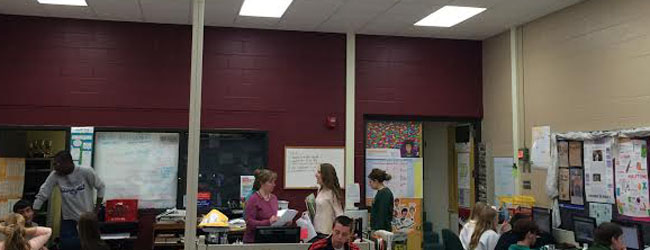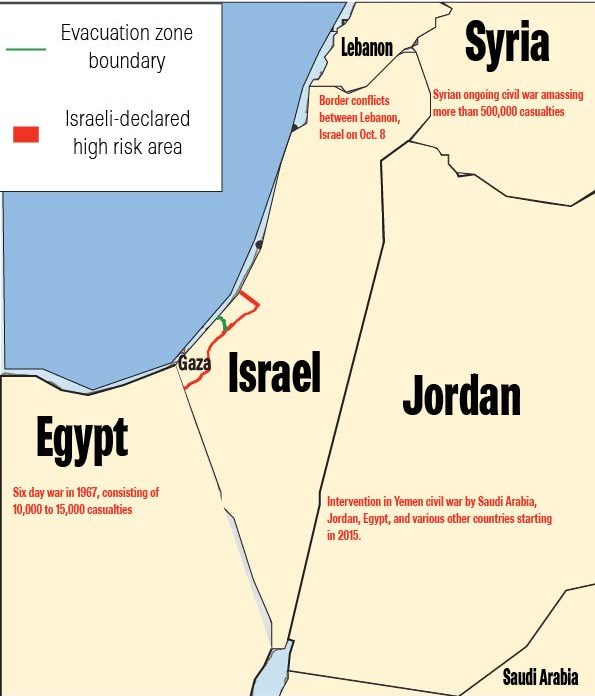In late February and early March, students at DHS narrow down what courses they plan to take for the next year. Some decide to challenge themselves with rigorous math courses like Calculus, while others embrace their creative side with classes such as IB Visual Art and Commercial Art. Some students even sign up for a class that will get their voice heard, such as Journalism, Debate and Yearbook.
However, although students may wish to take these classes, they aren’t always available. In order to run a class, a certain amount of students must be interested enough to sign up. The “magic” number changes each year depending on student population, but it usually is around the low 20s. Those who put the schedules together, such as Dow Counselor Lori Hallberg, often have students pick alternates so they will be prepared in the event a class does not run.
“That’s why we pick alternates for classes, just to be safe,” Hallberg said. “If a class ends up not running and we find that out in the summer time, then we don’t have to try to get a hold of everybody.”
This is helpful because it allows student to have a backup class if the one they really desired isn’t available.
There is also another requirement for a class to run: an allocated FTE requirement. An FTE, or a Full Time Equivalent, restricts the amount of classes the school can offer by assigning a point value system to each hour a teacher instructs a certain class.
“Every teacher at Dow High earns an equivalent of .1 FTE for every class they teach per semester,” assistant principal Ted Davis said. “For example, Mr. Gehoski teaches 5 classes here. He is going to teach 5 first semester and 5 second semester. So his FTE (.5 + .5) is 1.0. A 1.0 full time equivalent means I have a full time job.”
This differs per teacher, because some only teach a few hours per day, or split their time between different schools in the area. From each teacher’s point value, they have to create a sum under a certain number.
“Our typical FTE usually runs between 50 and 52 based on student population,” Davis said.
The FTE sum has been higher in the past, when there were more students at Dow. In future years, the population of Dow is expected to go down, along with the allocated FTE.
“For next year’s enrollment it’s going to be similar to what we’ve had this year, but the year after, as in ,once next year’s seniors graduate, the students coming in to replace them are about 60 to 70 students less,” Davis said. “Our school enrollment not next year, but the year after, unless something changes, will drop by about 70 kids.”
When the student population decreases, so will the allocated FTE amount. This may lead to a narrowing of class options, which could have a negative effect on our school. Davis believes that DHS should try to keep as many classes as possible, because the variety of curriculum it offers is what makes it so enticing to students in the area.
“Our curriculum is so diverse,” Davis said. “That’s what draws students into Dow High School.”
However, it’s too early to tell what classes will and will not be run at DHS next year.
“It’s very early in the staffing process, and students just placed course requests,” Davis said. “There is going to be a chance for parents to view and make changes to those course requests. Once that takes place, then basically the district will set a time frame and allocate a certain amount of FTE, which allows us to start our staffing process.”
This period of time allows parents and students to discuss what classes would be best for them to take and make changes if needed with their counselors.
“Over the next two weeks, parents are calling counselors and saying ‘I need to get out of this class or that class’,” Davis said. “Right now a class may have 28 kids, but if parents pull them out, there could be 18 in two weeks. At this point, I don’t even look at it.”
Classes like Yearbook, which wasn’t offered this year, is still an option students can choose for next year. If enough students sign up, there is still a chance it could be a class. Davis hopes it will, and believes that the yearbook is an important part of the school, along with the school newspaper.
“They’re recognized nationally,” Davis said. “Not to have a journalism class or school newspaper would be terrible.”
Luckily, other options are offered for classes that aren’t able to run. For example, the yearbook is being created this year by the Yearbook Club. However, because it isn’t required for a grade, there has been a lack of commitment of the club members.
“We started the year with about 50 people signed up for the club, which was amazing,” junior Julia Ahrns said. “As time went on, with sports and school, we’re down to about six or seven people.”
Because there is no grade incentive, some students lack the motivation to continue coming to the club and fulfilling their duties.
“We’re getting students that come in and want to help, but there’s no incentive for them to get stuff done,” Ahrns said. “People come in and say they’ll do stuff, but then drop off and don’t tell us. We’d rather you be up front with us and say ‘hey, I don’t have time for this’ but instead we’re hoping you keep coming back.”
This has put an immense pressure on the few members creating the yearbook. Each person is on multiple pages per deadline, which is extremely hard to manage. This time management is important to cost, because in order to get the yearbook printed, they have to make certain deadlines and are monetarily penalized if they don’t meet them. Luckily, the Yearbook Club has leftover funding from last year, when they didn’t miss a single deadline, but this year, they have missed a few, costing them $20 per page per day.
Members also deal with other outside activities that they have to manage their focus on. As a junior, Ahrns finds it hard to manage with her rigorous school work, and also her goal to swim at a collegiate level.
“It’s very hard for me to keep to keep my mind straight, and my brain is really scattered,” Arhns said.
The Yearbook staff have had to cut on some of the content, but overall feel like it will still be a good yearbook.
“On some pages we don’t have body copies, just because with the amount of time that we have, we don’t necessarily have time to write that,” Ahrns said. “For us, it’s more important to cover the whole season and the memories of it rather than trying to write something that we’re not going to be happy with.”
Although there have been significant cuts, Ahrns has high hopes. She also hopes that Dow students will see the effort the staff has made and really appreciate it.
“I think we’re going to have just as good of a book as we did last year,” Ahrns said. “It’s just something to keep in mind for all the students that they should be really thankful for the yearbook this year, because I’ve gone through weeks with [Cammie] Hall where we’ve only gotten three hours of sleep.”
Some of the students who signed up for the Yearbook were placed in Beginning Journalism or Adva nced Journalism, which have the same adviser as the yearbook, Hall. This is a compromise because they have an opportunity to work on yearbook pages when they have free time in class, and also easily have Hall’s guidance. The Beginning Journalism class also teaches students some yearbook skills, and has broadened on that this year.
“You have to go through a series of learning how to write captions, creating page designs, learning how to write body copies,” Ahrns said. “Normally [Hall] focuses on the Update style of doing things because you have to take Beginning Journalism in order to get into Advanced Journalism for the Update. But because we have so few people, she kind of flip-flopped it to focus a little bit more on the yearbook side of things.”
Lately, the Beginning Journalism class has been working on designing yearbook pages, which will actually be placed in this year’s edition.
“This deadline, they’re actually working on how to write sports stories, so we have them on sports pages, and they’re designing the full pages for the yearbook themselves,” Ahrns said. “During this two week time, they’re acting as our actual Yearbook class, I feel like an editor in chief again.”
This brings up the question of what other classes could be combined to add more variety. This has already happened at DHS, where .2 and .3 options are combined into one hour.
“Obviously the curriculum is just a little bit different,” Davis said. “But there may be different projects that everyone is doing.”
An example of this combined curriculum is Carol Lewin’s sixth hour IB Visual Arts and Commercial Art class. Senior Lauren Wall, a Commercial Art student in the class, questions how good it is for student education.
“It’s usually pretty good, but sometimes it’s really hard because Ms. Lewin has to split her time in between the two classes,” Wall said. “Sometimes you are really trying to figure something out in Com Art, and you need her help, but that day she’s helping the IB kid.”
The split class also limits the projects each side can do, and is a stress for the teacher to manage both.
“I’ve noticed the differences because I took Commercial Art last year too, and there’s projects that she doesn’t do any more with the commercial art kids, or she does them in a different order,” Wall said. “It’s hard for her and as a student it’s hard to get the projects done and try to manage and be aware of her and what she’s trying to do.”
Wall also insists that there is a noticeably larger difference between the two classes, and they do not mesh well together. Commercial Art is very structured, and is a business related art, which often creates designs for local businesses.
“Commercial Art is learning all the different design programs on the computer, like Adobe Illustrator, Photoshop and InDesign,” Wall said.
IB Visual Art is different in that it allows students to create their own projects based on what inspires them.
“In IB Art, you have a theme, which you work on all year until testing,” Wall said. “It’s really about finding what drives your art and why you’re passionate about art. You work on any project you want, but a certain percentage of it has to be related to your theme. You pick your own projects and manage your own time and do a sketchbook.”
Wall does not think combining classes is a good solution, but understands that it has to be done in order to keep the classes students desire.
“I think it would be way easier if they didn’t do the combined class again,” Wall said. “I understand that they have to and that they had to this year, so that’s fine, but it’s easier on the teachers and the students when it’s not combined.”
Davis believes that sometimes it is necessary in order to support our wide range of curriculum at DHS.
“The number of electives and core classes we offer far surpasses anything other schools can offer,” Davis said.
While he realizes it may be a pain for teachers, he believes it is greater for the school as a whole to maintain our diverse curriculum.
“I’d like to see every one of our classes full,” Davis said. “We want to see as wide a variety of classes as we can get here at Dow High.”



